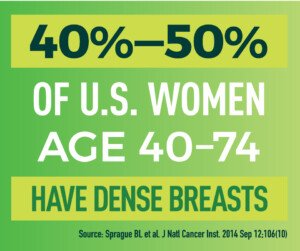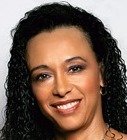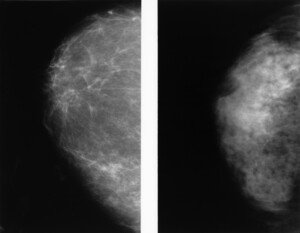There’s a reason why most of the medical establishment still does not take seriously high breast density as a major risk for breast cancer.
“The medical establishment follows the paradigm of diagnosing diseases, not preventing them,” says Mylaine Riobe, MD, founder of Riobe Institute of Integrative Medicine. Dr. Riobe, board certified in OB/GYN and integrative medicine, is the author of “The Answer to Cancer.”
And therein lies perhaps the best answer to “Why don’t more doctors take seriously the risk of dense breasts for breast cancer.”
Fair Questions
• How many hours of medical school are devoted to learning how to diagnose disease?
• How many hours of medical school are devoted to learning how to prevent disease?
• How about diagnose vs. prevention during medical internships and residencies?
• The paradigm is that how to diagnose and treat trumps how to prevent.
Dr. Riobe continues, “Integrative doctors are more of the mindset of prevention of diseases, which is what we need, to reverse the chaos seen in the healthcare industry today.”
We all know that medicine has come a brilliant way in the treatment of acute situations such as brain swelling from head trauma, torn aortas from car wrecks, third-degree burns, limbs ripped off in accidents, raging infections and other acute disasters that can occur to the human machine.
But our progress as far as prevention of the most prolific killer diseases is nothing short of appalling.
“It’s known that there is a slightly increased risk of breast cancer with fibrocystic breasts, and there are some preventive measures taken by the medical establishment, such as reduction of caffeine and increase of vitamins E and D,” says Dr. Riobe.
• Extremely dense breasts are made up primarily fibrocystic tissue.
• Heterogeneous density means dense mostly throughout but not as packed in there as with “extremely.”
• Scattered density means just as the word implies; areas here and there of fibrocystic tissue.
Dr. Riobe continues, “However, if we really look at the causes of fibrocystic breasts, what we should be doing is looking closely at nutrition and doing more comprehensive testing including nutrient testing and correction of deficits; hormone balancing and correction of imbalances, and also looking at the detoxification mechanisms, principally the liver and gastrointestinal system.
“There are new cutting-edge tests that we perform in integrative medicine that specifically target these items and allow us to reverse fibrocystic breasts over time.
“The medical establishment does have this type of testing available.”
It’s alarming that so many doctors turn a deaf ear to the risk factor of high breast density.

cancer.gov
“Dense breasts are not a disease until they progress to breast cancer,” says Dr. Riobe. “Again, the focus of the medical establishment is diagnosis of disease, not its prevention.
“This needs to change, as it has in integrative medicine. According to integrative medicine, dense breasts are a warning sign of poor detoxification (possible toxin overload or heavy metals) and possibly poor nutrition (possibly due to digestive problems such as infections or malabsorption).
“The testing to discover these problems is not available at the conventional medical doctor’s office and is only available through an integrative doctor.”
What Should Women with Dense Breasts Do
…if their doctor or HMO does not take seriously dense breasts as a strong risk factor for breast cancer?
If your HMO or medical plan doesn’t provide or cover 3D (tomosynthesis) mammograms, then pay for 3D out of pocket for your annual mammogram, skipping the 2D altogether, even though that’s covered by your insurance.
“3D mammograms are more sensitive than 2D or even digital mammograms,” says Dr. Riobe. “They can detect masses that 2D cannot.”
Just go ahead, pay out of pocket and get it done at a reputable imaging center. This should be a non-negotiable decision with your budget.
• 2D mammogram: walking on the ground outside a forest, looking for a bird inside the forest.
• 3D mammogram: flying above the forest, aerial view, looking for a bird inside the forest.
If your doctor doesn’t seem to be taking your concerns seriously about your dense breasts, don’t let this sway you away from taking extra cancer surveillance measures.
“Another option for breast cancer screening in the presence of dense breasts is thermography, which can be used in conjunction with a mammogram,” says Dr. Riobe.
“The thermogram is not hindered by dense breasts like the mammogram is. The mammo is an X-ray, so any dense tissue will reduce its ability to ‘see.’”
Furthermore, cancer on a mammogram image can look so much like fibrocystic tissue, that the risk of a radiologist missing the malignant mass is alarmingly real. It’s happened many times.
“The thermogram is looking for temperature fluctuations due to increased vascularity, which is seen in tumors, so it will not be hindered by dense breasts.”
NOTE: The yearly mammogram is never to be replaced by thermography. Think of thermography as an adjunct to the mammogram.
Additionally, women with dense breasts should undergo a screening exam via ultrasound. Again, accept the reality that you’ll likely be paying out of pocket. Just get it done.
If the imaging facility requires your doctor’s authorization for an ultrasound, ask your doctor for it. Then get it done.
There’s Hope Yet…
There once was a time when doctors were recommending smoking to patients to relax them.
It took many years for the medical establishment to 100 percent reverse their take on the dangers of smoking.
Slowly but surely, the medical establishment is moving towards taking very seriously the breast cancer risk of dense breasts.

Dr. Riobe has helped thousands of patients overcome difficult illnesses by addressing root causes, not just masking symptoms. She has over 15 years’ experience using integrative techniques to treat diverse patients.
 Lorra Garrick has been covering medical, fitness and cybersecurity topics for many years, having written thousands of articles for print magazines and websites, including as a ghostwriter. She’s also a former ACE-certified personal trainer.
Lorra Garrick has been covering medical, fitness and cybersecurity topics for many years, having written thousands of articles for print magazines and websites, including as a ghostwriter. She’s also a former ACE-certified personal trainer.
.












